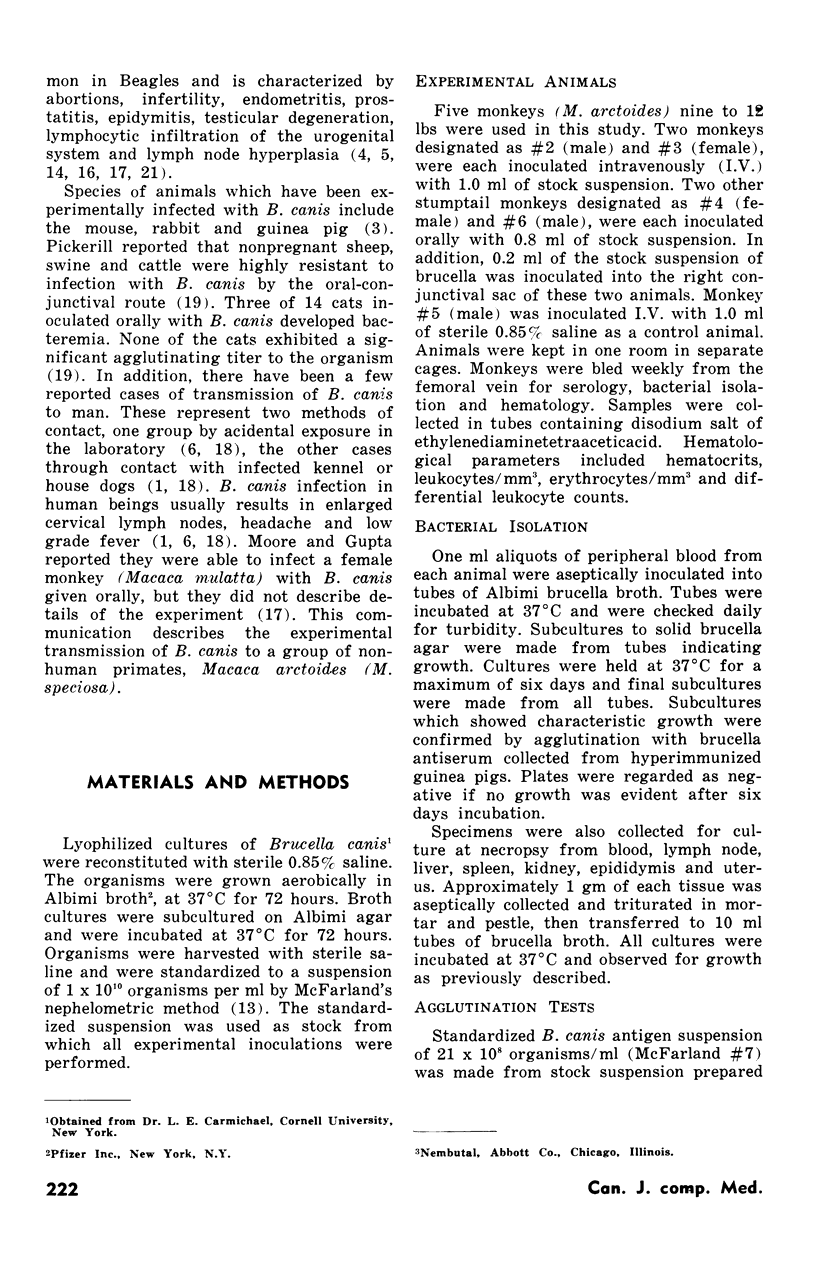Abstract
Four stumptail Macaque monkeys (Macaca arctoides) were each inoculated with approximately 1010 organisms from a culture of Brucella canis. Two animals were inoculated via the oral and conjunctival route and the other two monkeys were inoculated intravenously with the organisms. A fifth animal served as a control. Blood samples were taken at weekly intervals for hematological, serological and bacterialogical studies. The monkeys were killed at five and ten weeks post-inoculation and tissues taken from a variety of organs for bacterial culture. B. canis was isolated from the peripheral blood of inoculated monkeys for up to seven weeks post inoculation and all infected monkeys developed significant neutralizing antibody titers to the organism. The bacterium was isolated from some tissues, including the uterus of one monkey, in the two animals killed at five weeks post-inoculation. Focal granulomatous lesions were sometimes observed in the liver, spleen and lymphoid tissue of inoculated monkeys. Such lesions are similar to those described in other brucella infections. Human infections with B. canis have occurred and the possible dangers entailed in exposure to the organism should again be emphasized.
Full text
PDF




Images in this article
Selected References
These references are in PubMed. This may not be the complete list of references from this article.
- BRAUDE A. I. Studies in the pathology and pathogenesis of experimental brucellosis. II. The formation of the hepatic granuloma and its evolution. J Infect Dis. 1951 Jul-Aug;89(1):87–94. doi: 10.1093/infdis/89.1.87. [DOI] [PubMed] [Google Scholar]
- Carmichael L. E. Canine brucellosis: isolation, diagnosis, transmission. Proc Annu Meet U S Anim Health Assoc. 1967;71:517–527. [PubMed] [Google Scholar]
- Carmichael L. E., Kenney R. M. Canine abortion caused by Brucella canis. J Am Vet Med Assoc. 1968 Mar 15;152(6):605–616. [PubMed] [Google Scholar]
- Carmichael L. E., Kenney R. M. Canine brucellosis: the clinical disease, pathogenesis, and immune response. J Am Vet Med Assoc. 1970 Jun 15;156(12):1726–1734. [PubMed] [Google Scholar]
- Faigel H. C. Beagle fever, canine brucellosis. Clin Pediatr (Phila) 1969 Feb;8(2):59–59. doi: 10.1177/000992286900800203. [DOI] [PubMed] [Google Scholar]
- Gleiser C. A., Sheldon W. G., Van Hoosier G. L., Hill W. A. Pathologic changes in dogs infected with a Brucella organism. Lab Anim Sci. 1971 Aug;21(4):540–545. [PubMed] [Google Scholar]
- Hall W. H. Epidemic brucellosis in beagles. J Infect Dis. 1971 Dec;124(6):615–618. doi: 10.1093/infdis/124.6.615. [DOI] [PubMed] [Google Scholar]
- Hunt A. C., Bothwell P. W. Histological findings in human brucellosis. J Clin Pathol. 1967 May;20(3):267–272. doi: 10.1136/jcp.20.3.267. [DOI] [PMC free article] [PubMed] [Google Scholar]
- Moore J. A., Bennett M. A previously undescribed organism associated with canine abortion. Vet Rec. 1967 May 20;80(20):604–605. doi: 10.1136/vr.80.20.604. [DOI] [PubMed] [Google Scholar]
- Moore J. A., Gupta B. N., Conner G. H. Eradication of Brucella canis infection from a dog colony. J Am Vet Med Assoc. 1968 Sep 1;153(5):523–527. [PubMed] [Google Scholar]
- Moore J. A., Gupta B. N. Epizootiology, diagnosis, and control of Brucella canis. J Am Vet Med Assoc. 1970 Jun 15;156(12):1737–1740. [PubMed] [Google Scholar]
- Moore J. A., Kakuk T. J. Male dogs naturally infected with Brucella canis. J Am Vet Med Assoc. 1969 Oct 15;155(8):1352–1358. [PubMed] [Google Scholar]
- Morisset R., Spink W. W. Epidemic canine brucellosis due to a new species, brucella canis. Lancet. 1969 Nov 8;2(7628):1000–1002. doi: 10.1016/s0140-6736(69)90551-0. [DOI] [PubMed] [Google Scholar]
- Pickerill P. A. Comments on epizootiology and control of canine brucellosis. J Am Vet Med Assoc. 1970 Jun 15;156(12):1741–1742. [PubMed] [Google Scholar]
- Spink W. W. Comments on canine brucellosis due to Brucella canis. J Am Vet Med Assoc. 1970 Jun 15;156(12):1734–1736. [PubMed] [Google Scholar]
- Swenson R. M., Carmichael L. E., Cundy K. R. Human infection with Brucella canis. Ann Intern Med. 1972 Mar;76(3):435–438. doi: 10.7326/0003-4819-76-3-435. [DOI] [PubMed] [Google Scholar]




